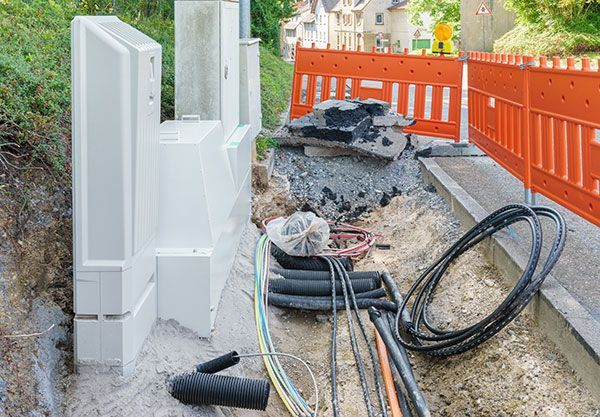Cable trenching is a method of laying cables into the ground by digging trenches. The cables are submerged underground via the trench and are then covered by a layer of earth, bitumen or concrete. Cable trenching, also known as underground cabling, became a popular method of installing cables in the early 90s. It is the bread and butter of the telecommunication industry as installing cables in trenches is a safe and effective way to protect cables from weather damage. This blog will outline the basics of cable trenching.
When is Cable Trenching Used?
Trenching is used frequently in roadways and footpaths for installation conduits, pits, and cables. Open trench cable laying is a popular method for a range of telecommunication and internet installation services. Cables that most frequently use the cable trenching installation method is the NBN, telecommunication cables, fibre optic installation, data cabling, electrical cabling, and AV cabling.
The Importance of Trenching Sizes
When installing underground cables, an important aspect to consider is the depth and width of the trench. To successfully bury a cable, the trench must be dug and prepared properly. The trench must be of adequate size for the cables and ducting. The size of the cable will heavily dictate the size trench you need to dig.
Machines Used for Cable Trenching
When installing cables, the type of machine you use will be impacted by the area you’re digging in. If you’re laying cable in a built-up area where there is a high chance of underground utilities being located, then a vacuum truck will be a suitable option.
Sucker trucks offer a non-destructive method of creating trenches which won’t damage pipes, cables, and utilities buried beneath the surface. If you’re sure that there won’t be any lines buried in the area you need to excavate, a ride-on trencher is a suitable machine to create the desired trench depth and width you require. On larger cable trenching projects excavators, tractors, or skid steers can utilise a trencher attachment to perform open trench cable laying.
Cable Trenching with CableNet Industries
The team at CableNet Industries have experienced cable layers and have complete a range of cabling services in rural, residential and civil locations. We can assist your next cable installation project from our offices in Sunshine West, Victoria and Yatala, Queensland. We provide cable trenching services Australia-wide including across Brisbane, Sydney, Canberra, Melbourne, Perth, Darwin, and beyond. Contact us to discuss our cable trenching services by giving us a call or filling out our online form.
Cable Trenching FAQ's
What is cable trenching?
Cable trenching is the process of laying cables underground by digging trenches. Cables are placed in the trench and covered with earth, bitumen, or concrete to protect them from damage. This method is widely used in the telecommunication industry for safe and durable cable installation.
When is cable trenching commonly used?
Cable trenching is commonly used for laying conduits, pits, and cables in roadways and footpaths. It is particularly popular for installing telecommunication cables, fibre optics, data cabling, electrical cabling, and AV cabling.
Why are trench sizes important in cable trenching?
The depth and width of the trench are crucial for proper cable installation. The trench must accommodate the size of the cables and ducting to ensure they are securely buried and protected.
What machines are used for cable trenching?
The choice of machine depends on the digging area. For built-up areas with underground utilities, vacuum trucks (sucker trucks) are ideal as they avoid damaging buried lines. For open areas, ride-on trenchers, excavators, tractors, or skid steers with trencher attachments can be used for larger projects.
Where does CableNet Industries provide cable trenching services?
CableNet Industries offers cable trenching services across Australia, including Brisbane, Sydney, Canberra, Melbourne, Perth, Darwin, and beyond. Their team has extensive experience handling cable installation projects in rural, residential, and civil locations.

